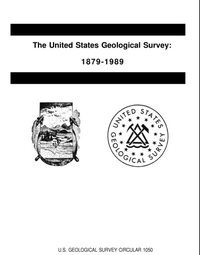The United States Geological Survey: 1879-1989
Links
- More information: USGS Index Page (html)
- Documents:
- Download citation as: RIS | Dublin Core
Abstract
The United States Geological Survey was established on March 3, 1879, just a few hours before the mandatory close of the final session of the 45th Congress, when President Rutherford B. Hayes signed the bill appropriating money for sundry civil expenses of the Federal Government for the fiscal year beginning July 1, 1879. The sundry civil expenses bill included a brief section establishing a new agency, the United States Geological Survey, placing it in the Department of the Interior, and charging it with a unique combination of responsibilities: 'classification of the public lands, and examination of the geological structure, mineral resources, and products of the national domain.' The legislation stemmed from a report of the National Academy of Sciences, which in June 1878 had been asked by Congress to provide a plan for surveying the Territories of the United States that would secure the best possible results at the least possible cost. Its roots, however, went far back into the Nation's history. The first duty enjoined upon the Geological Survey by the Congress, the classification of the public lands, originated in the Land Ordinance of 1785. The original public lands were the lands west of the Allegheny Mountains claimed by some of the colonies, which became a source of contention in writing the Articles of Confederation until 1781 when the States agreed to cede their western lands to Congress. The extent of the public lands was enormously increased by the Louisiana Purchase in 1803 and later territorial acquisitions. At the beginning of Confederation, the decision was made not to hold the public lands as a capital asset, but to dispose of them for revenue and to encourage settlement. The Land Ordinance of 1785 provided the method of surveying and a plan for disposal of the lands, but also reserved 'one-third part of all gold, silver, lead, and copper mines to be sold or otherwise disposed of, as Congress shall thereafter direct,' thus implicitly requiring classification of the lands into mineral and nonmineral. Mapping of the public lands was begun under the direction of the Surveyor-General, but no special provision was made for classification of the public lands, and it thus became the responsibility of the surveyor. There was,of course, no thought in 1785 or for many years thereafter of employing geologists to make the classification of the mineral lands, for geology was then only in its infancy.
| Publication type | Report |
|---|---|
| Publication Subtype | USGS Numbered Series |
| Title | The United States Geological Survey: 1879-1989 |
| Series title | Circular |
| Series number | 1050 |
| DOI | 10.3133/cir1050 |
| Year Published | 1989 |
| Language | English |
| Publisher | U.S. Geological Survey |
| Contributing office(s) | Library, Core Science Analytics, Synthesis, and Libraries |
| Description | v, 52 p. |
| Online Only (Y/N) | N |
| Additional Online Files (Y/N) | N |


